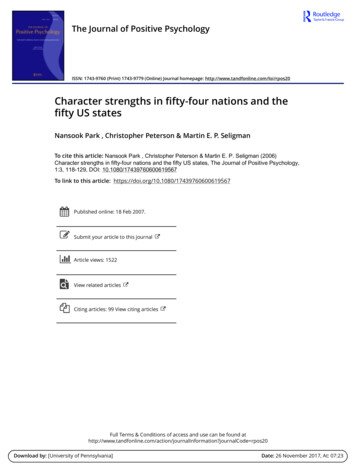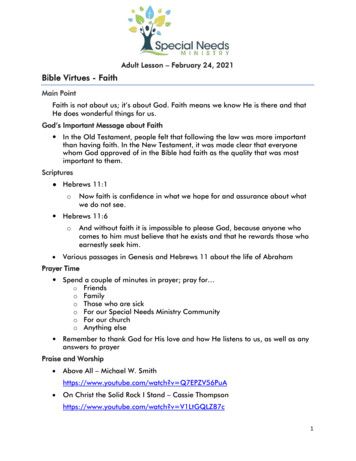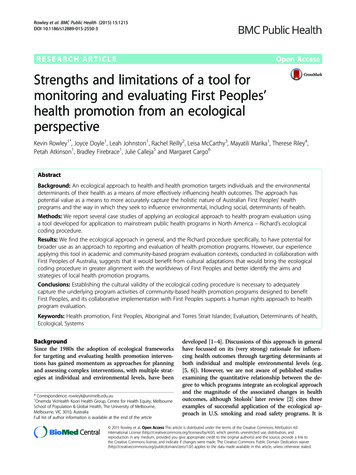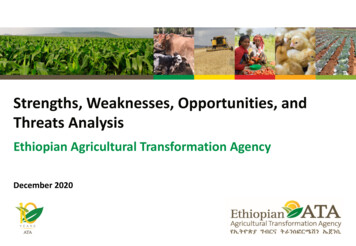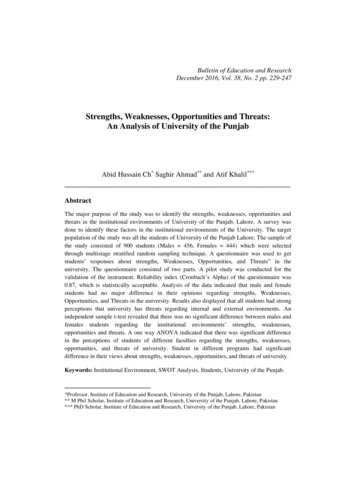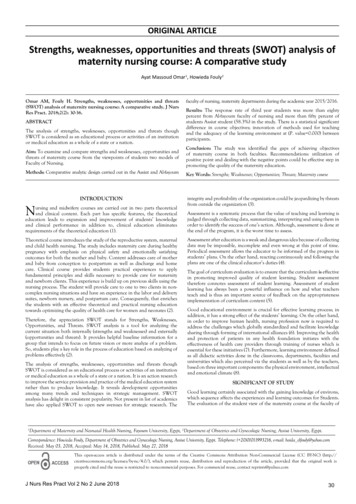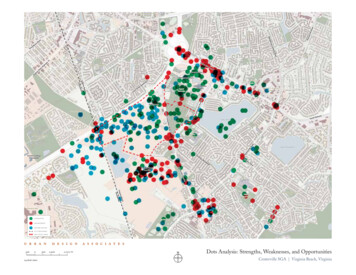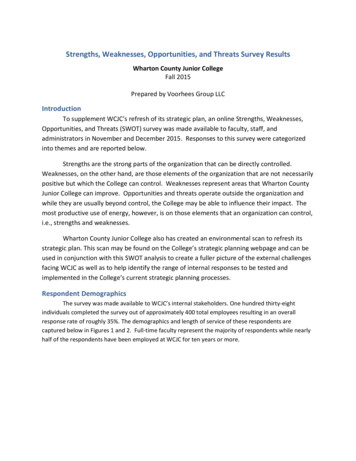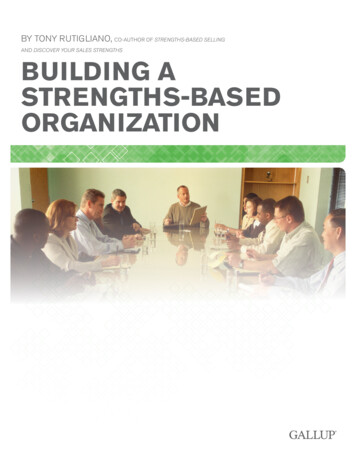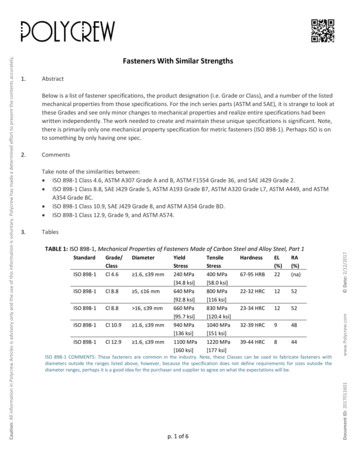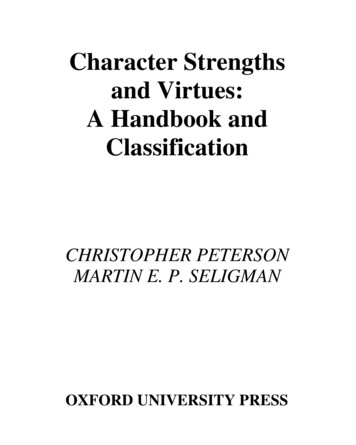
Transcription
Character Strengthsand Virtues:A Handbook andClassificationCHRISTOPHER PETERSONMARTIN E. P. SELIGMANOXFORD UNIVERSITY PRESS
CharacterStrengthsand Virtues
The work contained herein is that of the Values in Action Institute,a nonprofit initiative of the Manuel D. and Rhoda Mayerson Foundation,directed by Dr. Neal H. Mayerson. Donald O. CliftonMihalyi CsikszentmihalyiEd DienerRaymond D. FowlerBarbara L. FredricksonHoward GardnerDavid MyersC. Rick SnyderCharles SpielbergerClaude SteeleRobert J. SternbergGeorge VaillantEllen Winner
CharacterStrengthsand VirtuesA Handbook and ClassificationChristopher Peterson & Martin E. P. Seligman12004
3Oxford New YorkAuckland Bangkok Buenos Aires Cape Town ChennaiDar es Salaam Delhi Hong Kong Istanbul Karachi KolkataKuala Lumpur Madrid Melbourne Mexico City Mumbai NairobiSão Paulo Shanghai Taipei Tokyo TorontoCopyright 2004 by Values in Action InstitutePublished by American Psychological Association750 First Street, NE, Washington, DC 20002-4242www.apa.organdOxford University Press, Inc.198 Madison Avenue, New York, New York 10016www.oup.comOxford is a registered trademark of Oxford University PressAll rights reserved. No part of this publication may be reproduced,stored in a retrieval system, or transmitted, in any form or by any means,electronic, mechanical, photocopying, recording, or otherwise,without the prior permission of Oxford University Press.Library of Congress Cataloging-in-Publication DataPeterson, Christopher, 1950 Feb. 18–Character strengths and virtues : a handbook and classification / Christopher Peterson,Martin E. P. Seligmanp. cm.Includes bibliographical references (p. ).ISBN 0-19-516701-51. Character—Handbooks, manuals, etc. 2. Virtues—Handbooks, manuals, etc. I. Seligman,Martin E. P. II. Title.BF818 .P38 2004155.2'32—dc2220030243209 8 7 6 5 4 3 2 1Printed in the United States of Americaon acid-free paper
PrefaceCan we hold hope that positive psychology will be able to help people evolvetoward their highest potential?” The classification described in this bookbegan with this question, posed by Neal Mayerson to Martin Seligman in 1999.The Mayerson Foundation was concerned that inadequate progress was beingmade from well-worn problem-fixing approaches and that an approach basedon recognizing people’s strengths and aspirations might prove more effective.Mayerson turned to Seligman to explore the intersection of the emerging fieldof positive youth development and Seligman’s new push to articulate a newpositive psychology. It soon became clear that two prior questions needed tobe answered: (1) how can one define the concepts of “strength” and “highestpotential” and (2) how can one tell that a positive youth development programhas succeeded in meeting its goals?These two concerns framed the classification project from its inception. TheManuel D. and Rhoda Mayerson Foundation created the Values in Action (VIA)Institute, a nonprofit organization dedicated to the development of a scientificknowledge base of human strengths. Seligman was the scientific director of theVIA Institute, and he asked Christopher Peterson to be its project director. InSeptember 2000, Peterson temporarily relocated from the University of Michigan to the University of Pennsylvania. For the next three years, Seligman andPeterson, with the assistance of a prestigious array of scholars and practitioners,devised a classification of character strengths and virtues (addressing the “good”teenager concern) and ways of measuring them (addressing the program evaluation concern). This book describes the results of this collaboration. We remaingreatly interested in positive youth development but now believe that the classification and measurement strategies we have created can be applied muchmore broadly.We have been helped mightily along the way. Our specal gratitude is ofcourse expressed to the Manuel D. and Rhoda Mayerson Foundation for cre-
vi ating the VIA Institute, which supported this work. Thanks in particular aredue to Neal Mayerson for his vision and encouragement.Thanks are also due more generally to the other benefactors and boostersof positive psychology. Don Clifton of the Gallup Organization, along with Martin Seligman, convened a meeting of scholars to begin a delineation of thestrengths. Much of what follows builds on this beginning. The late RobertNozick as well as Mihalyi Csikszentmihalyi, George Vaillant, Daniel Robinson,Kathleen Hall Jamieson, and Ed Diener were the heavyweights at this meeting.Three subsequent meetings were held as well, and we thank those in attendancefor their important contributions to this project: Bonnie Bernard, AlanBlankstein, Robert Blum, Dale Blyth, Jack Burke, Gaye Carlson, Sonia Chessen,Reginald Clark, Joseph Conaty, Katherine Dahlsgaard, Lucy Davidson, Ed Diener, Elizabeth Dunn, Thaddeus Ferber, Raymond Fowler, Carissa Griffing,Daniel Hart, Derek Isaacowitz, Terry Kang, Robert Kendall, Nicole Kurzer,Kenneth Maton, Donna Mayerson, Neal Mayerson, Richard McCarty, PeterNathan, Heather Johnston Nicholson, Joyce Phelps, Karen Pittman, Jane Quinn,Gordon Raley, Mark Rosenberg, Peter Schulman, David Seligman, AndrewShatté, Myrna Shure, Susan Spence, Peter Stevens, Philip Stone, ConstanciaWarren, Alan Williams, Steve Wolin, and Nicole Yohalem.The Atlantic Philanthropies, the John Marks Templeton Foundation, theAnnenberg/Sunnylands Trust Foundation, and the Department of Educationall funded aspects of this project and by supporting positive psychology generously created an atmosphere in which our classification project could be seenas a worthy one.Individual chapters in Section II of this book were drafted by expert socialscientists—see the list of contributors (pp. xiii–xiv)—commissioned by us toreview what was known about the various character strengths in the classification. We were fortunate that virtually all of our first choices were able towrite these drafts. In a few cases, we commissioned two separate drafts for agiven character strength, and these drafts were then melded. All the drafts werethoughtful and thorough, and we think that a fine book would have resultedsimply from gathering them together, even without our editing. However, wetook a further step and rewrote each draft for consistency in organization andtone. Our editing was deliberately heavy-handed, and the contributors shouldnot be held responsible for any resulting errors.We were also fortunate to have the advice of distinguished senior social scientists—see the Board of Advisors (p. ii)—while we worked on this project. Inparticular, the wisdom and support of George Vaillant kept us on track.Very early chapter drafts were reviewed by youth development experts—Bonnie Bernard, Robert Blum, Reginald Clark, Daniel Hart, Heather JohnstonNicholson, and Kenneth Maton—in a process coordinated by Nicole Yohalemand Karen Pittman of the International Youth Foundation. Later chapter draftswere reviewed by Donald K. Freedheim, Jerold R. Gold, William C. Howell,
Thomas E. Joiner, Randy J. Larsen, and Lee B. Sechrest, and we thank them fortheir thoughtful suggestions.We want to thank Gary VandenBos of the American Psychological Association and Joan Bossert of Oxford University Press—both organizations aregreat friends of positive psychology—for working together to publish this book.We also want to thank Marion Osmun of the American Psychological Association for her editorial work and Susan Ecklund for her thorough copyediting.We are grateful to Peter Schulman, Terry Kang, Linda Newsted, ChrisJenkins, and Patty Newbold for their help behind the scenes. Lisa Christie andJennifer Yu brought their sharp eyes and good humor to early drafts of themanuscript. Ilona Boniwell, Tiffany Sawyer, Lauren Kachorek, Tracy Steen,Angela Lee Duckworth, Rachel Kellerman, Robert Biswas-Diener, Emily Polak,Adam Cohen, and Derek Isaacowitz helped with some of the research describedhere. Katherine Dahlsgaard identifed the six core virtues—wisdom, courage,humanity, justice, temperance, and transcendence—used to organize the specific character strengths in the classification. Nansook Park has been a valuedcollaborator.We thank Mihalyi Csikszentmihalyi, Ed Diener, Kathleen Hall Jamieson,and George Vaillant for their leadership on the Positive Psychology SteeringCommittee. We are grateful as well to Don Clifton, Jim Clifton, and MarcusBuckingham of the Gallup Organization for pioneering work on strengths andshowing us that a psychology of human strengths was possible.And we of course want to thank the more than 150,000 individuals whocompleted versions of our measures during the past 3 years.Last, but certainly not least, our families and friends deserve special mention for embodying the strengths that constitute the classification. Virtue maybe its own reward, but we too reaped the benefits.vii
This page intentionally left blank
ContentsContributorsxiii : BACKGROUND1 Introduction to a “Manual of the Sanities” 32 Universal Virtues?—Lessons From History 333 Previous Classifications of Character Strengths 53 : STRENGTHS OF CHARACTERStrengths of WISDOM AND KNOWLEDGEIntroduction934 Creativity [Originality, Ingenuity] 1095 Curiosity [Interest, Novelty-Seeking,Openness to Experience] 1256 Open-Mindedness [Judgment, Critical Thinking] 1437 Love of Learning 1618 Perspective [Wisdom] 181
x Strengths of COURAGEIntroduction 1979 Bravery [Valor] 21310 Persistence [Perseverance, Industriousness] 22911 Integrity [Authenticity, Honesty] 24912 Vitality [Zest, Enthusiasm, Vigor, Energy] 273Strengths of HUMANITYIntroduction 29113 Love30314 Kindness [Generosity, Nurturance, Care,Compassion, Altruistic Love, “Niceness”] 32515 Social Intelligence [Emotional Intelligence,Personal Intelligence] 337Strengths of JUSTICEIntroduction 35516 Citizenship [Social Responsibility, Loyalty, Teamwork] 36917 Fairness 39118 Leadership 413Strengths of TEMPERANCEIntroduction 42919 Forgiveness and Mercy 44520 Humility and Modesty 461
21 Prudence47722 Self-Regulation [Self-Control] 499Strengths of TRANSCENDENCEIntroduction51723 Appreciation of Beauty and Excellence[Awe, Wonder, Elevation] 53724 Gratitude55325 Hope [Optimism, Future-Mindedness,Future Orientation] 56926 Humor [Playfulness] 58327 Spirituality [Religiousness, Faith, Purpose] 599 : CONCLUSIONS28 Assessment and Applications 625References 645Index of Names 763Subject Index789xi
This page intentionally left blank
ContributorsRoy F. Baumeister (Humility and Modesty; Self-Regulation)Marvin W. Berkowitz (Fairness)Jessey H. Bernstein (Vitality)W. Keith Campbell (Humility and Modesty)Katherine Dahlsgaard (Lessons from History)Lucy Davidson (Integrity)Robert A. Emmons (Gratitude)Julie Juola Exline (Humility and Modesty)Constance A. Flanagan (Citizenship)Jonathan Haidt (Appreciation of Beauty)Andrew C. Harter (Persistence)Pamela S. Hartman (Perspective)Nick Haslam (Prudence)Cindy Hazan (Love)Thomas E. Joiner (Humility and Modesty)Lauren V. Kachorek (Humility and Modesty)Todd B. Kashdan (Curiosity)Dacher Keltner (Appreciation of Beauty)Joachim I. Krueger (Humility and Modesty)Jacqueline S. Mattis (Spirituality)xiii
xiv John D. Mayer (Social Intelligence)Michael E. McCullough (Forgiveness and Mercy; Kindness)Nansook Park (Assessment and Applications)Elizabeth Pollard (Integrity)Stephen G. Post (Kindness)K. Ann Renninger (Love of Learning)Willibald Ruch (Humor)Richard M. Ryan (Vitality)Peter Salovey (Social Intelligence)Carol Sansone (Love of Learning)Kennon M. Sheldon (Integrity)Stephen A. Sherblom (Fairness)Dean Keith Simonton (Creativity)Jessi L. Smith (Love of Learning)Tracy A. Steen (Bravery)Dianne M. Tice (Persistence)Kathleen D. Vohs (Self-Regulation)Harry M. Wallace (Persistence)Monica C. Worline (Bravery)Stephen J. Zaccaro (Leadership)
Section iBackground
This page intentionally left blank
1. Introduction toa “Manual of the Sanities”The classification of strengths presented in this book is intended to reclaimthe study of character and virtue as legitimate topics of psychologicalinquiry and informed societal discourse. By providing ways of talking aboutcharacter strengths and measuring them across the life span, this classification will start to make possible a science of human strengths that goes beyondarmchair philosophy and political rhetoric. We believe that good charactercan be cultivated, but to do so, we need conceptual and empirical tools to craftand evaluate interventions.In recent years, strides have been made in understanding, treating, andpreventing psychological disorders. Reflecting this progress and critically helping to bring it about are widely accepted classification manuals—the Diagnostic and Statistical Manual of Mental Disorders (DSM) sponsored by theAmerican Psychiatric Association (1994) and the International Classification ofDiseases (ICD) sponsored by the World Health Organization (1990)—whichhave generated a family of reliable assessment strategies and have led to demonstrably effective treatments for more than a dozen disorders that only a fewdecades ago were intractable (Nathan & Gorman, 1998, 2002; Seligman, 1994).Lagging behind but still promising in their early success are ongoing efforts todevise interventions that prevent various disorders from occurring in the firstplace (e.g., M. T. Greenberg, Domitrovich, & Bumbarger, 1999).Consensual classifications and associated approaches to assessment provide a common vocabulary for basic researchers and clinicians, allowing communication within and across these groups of professionals as well as with thegeneral public. Previous generations of psychiatrists and psychologists had nocertainty, for example, that patients in London who were diagnosed with schizophrenia had much in common with patients in Topeka receiving the same diagnosis. They had no reason to believe that an effective psychological or3
4section i: Backgroundpharmaceutical treatment of ostensible depressives in Johannesburg would beuseful for supposed depressives in Kyoto.With recent incarnations of the DSM and ICD, matters have begun tochange, but only for half of the landscape of the human condition. We can nowdescribe and measure much of what is wrong with people, but what about thosethings that are right? Nothing comparable to the DSM or ICD exists for the goodlife. When psychiatrists and psychologists talk about mental health, wellness,or well-being, they mean little more than the absence of disease, distress, anddisorder. It is as if falling short of diagnostic criteria should be the goal for whichwe all should strive. Insurance companies and health maintenance organizations (HMOs) reimburse the treatment of disorders but certainly not the promotion of happiness and fulfillment. The National Institute of Mental Health(NIMH) should really be called the National Institute of Mental Illness becauseit devotes but a fraction of its research budget to mental health.This handbook focuses on what is right about people and specifically aboutthe strengths of character that make the good life possible. We follow the example of the DSM and ICD and their collateral creations by proposing a classification scheme and by devising assessment strategies for each of its entries. Thecrucial difference is that the domain of concern for us is not psychological illness but psychological health. In short, our goal is “a manual of the sanities”(Easterbrook, 2001, p. 23).We write from the perspective of positive psychology, which means thatwe are as focused on strength as on weakness, as interested in building thebest things in life as in repairing the worst, and as concerned with fulfillingthe lives of normal people as with healing the wounds of the distressed(Seligman, 2002). The past concern of psychology with human problems isof course understandable and will not be abandoned anytime in the foreseeable future. Problems always will exist that demand psychological solutions,but psychologists interested in promoting human potential need to pose different questions from their predecessors who assumed a disease model ofhuman nature. We disavow the disease model as we approach character, andwe are adamant that human strengths are not secondary, derivative, illusory,epiphenomenal, parasitic upon the negative, or otherwise suspect. Said in apositive way, we believe that character strengths are the bedrock of the human condition and that strength-congruent activity represents an importantroute to the psychological good life.What distinguishes positive psychology from the humanistic psychologyof the 1960s and 1970s and from the positive thinking movement is its relianceon empirical research to understand people and the lives they lead. Humanistswere often skeptical about the scientific method and what it could yield yet wereunable to offer an alternative other than the insight that people were good. Incontrast, positive psychologists see both strength and weakness as authentic andas amenable to scientific understanding.
chapter 1: Introduction to a “Manual of the Sanities”There are many good examples of ongoing psychological research that fitunder the positive psychology umbrella (see collections by Aspinwall &Staudinger, 2003; Cameron, Dutton, & Quinn, 2003; Chang, 2001; Gillham,2000; Keyes & Haidt, 2003; R. M. Lerner, Jacobs, & Wertlieb, 2003; Snyder,2000b; Snyder & Lopez, 2002), but this new field lacks a common vocabularythat agrees on the positive traits and allows psychologists to move among instances of them. We imagine that positive psychology as a whole would be benefited—indeed, shaped and transformed—by agreed-upon ways for speakingabout the positive, just as the DSM and ICD have shaped psychiatry, clinicalpsychology, and social work by providing a way to speak about the negative.We believe that the classification of character presented here is an importantstep toward a common vocabulary of measurable positive traits.Our project coincides with heightened societal concern about good character (Hunter, 2000). After a detour through the hedonism of the 1960s, thenarcissism of the 1970s, the materialism of the 1980s, and the apathy of the 1990s,most everyone today seems to believe that character is important after all andthat the United States is facing a character crisis on many fronts, from the playground to the classroom to the sports arena to the Hollywood screen to business corporations to politics. According to a 1999 survey by Public Agenda,adults in the United States cited “not learning values” as the most importantproblem facing today’s youth. Notably, in the public’s view, drugs and violencetrailed the absence of character as pressing problems.But what is character? So long as we fail to identify the specifics, different groups in our society—despite their common concern for human goodness—will simply talk past one another when attempting to address the issue.For instance, is character defined by what someone does not do, or is there amore active meaning? Is character a singular characteristic of an individual,or is it composed of different aspects? Does character—however we defineit—exist in degrees, or is character just something that one happens, like pregnancy, to have or not? How does character develop? Can it be learned? Can itbe taught, and who might be the most effective teacher? What roles are playedby families, schools, peers, youth development programs, the media, religiousinstitutions, and the larger culture? Is character socially constructed and ladenwith idiosyncratic values, or are there universals suggesting a more enduringbasis?The emerging field of positive psychology is positioned to answer these sortsof questions. Positive psychology focuses on three related topics: the study ofpositive subjective experiences, the study of positive individual traits, and thestudy of institutions that enable positive experiences and positive traits(Seligman & Csikszentmihalyi, 2000). Our classification project addresses thesecond of these topics and in so doing hopes to shed light on the first. One eventual benefit of the classification we propose may be the identification or eventhe deliberate creation of institutions that enable good character.5
6section i: Background Thinking About Classification: Lessons From SystematicsLike everyday people, social scientists are fond of making lists: for example,enumerating defense mechanisms, emotional disorders, personality traits, jobtypes, psychosexual stages, parenting practices, attachment styles, and so on.Unlike everyday people, social scientists often go on to reify their lists by givingthem “scientific” labels like classifications or taxonomies. Scientific credibilityis not gained by assertion but by making sure that the label fits. We call ourendeavor an aspirational classification. What does this mean?A scientific classification parses some part of the universe first by demarcating its domain and second by specifying mutually exclusive and exhaustivesubcategories within that domain. Both sorts of parsing rules need to be explicit and demonstrably reliable. The validity of a classification is judged by itsutility vis-à-vis one or more stated purposes. Are classifiers more interested inmarking the perimeter of a scientific territory or in detailing an already agreedupon domain? Is the classification intended to catalog already known instancesor to accommodate new ones as they are encountered? Is it intended to inspireresearch or to guide intervention?A classification should not be confused with a taxonomy, which is based ona deep theory that explains the domain of concern (K. D. Bailey, 1994). Why theseentries but not others? What is the underlying structure? That is, how do theentries relate to one another? When melded with evolutionary theory, for example,the Linnaean classification of species becomes a profound theory of life and thecourse that it has taken over the millennia. A good taxonomy has the benefits ofa good theory: It organizes and guides the activity of an entire discipline.But there is an important caution here. Along with their added value, taxonomies have a cost not incurred by classifications. Suppose the theory that girdsa taxonomy is wrong, contradictory, or inarticulate? Then the activity that isorganized and guided becomes self-defeating. Furthermore, it proves highly difficult to change the entries of a taxonomy, even in minor ways, because so muchelse linked together by the deep theory needs to be altered as a consequence.Our classification is concerned with human strengths and virtues. Fromthe perspective of positive psychology, itself a new endeavor, the domain ofhuman excellence is largely unexplored. At the beginning of this project, wecreated a tentative “taxonomy,” but it proved beyond our ability to specify areasonable theory (as a taxonomy requires). However, our efforts did convinceus that it was possible to approach closely the classification goals of staking outterritory (i.e., defining virtues valued in most cultures) and subdividing it (i.e.,specifying instances of these virtues). Our measurement intent of necessity ledus to articulate explicit rules for what counts as a strength or not (inclusion andexclusion criteria) and for distinguishing various strengths from one another.These rules further provide the basis for adding new instances of characterstrengths to the classification.
chapter 1: Introduction to a “Manual of the Sanities”We already knew our constituencies—psychology researchers and practitioners—and their needs kept us on task as we devised assessment strategies.We disavow all intents to propose a taxonomy in the technical sense, eventhough previous drafts of our work used that term. A modest description ofour endeavor—an aspirational classification of strengths and virtues—preservesthe flexibility necessary to proceed. A thoughtful classification, even if tentative, will serve the goals of psychology more productively than a flawed taxonomy, even if the surface entries look exactly the same. We trust to theemerging field of positive psychology as a whole to create one or more theoriesthat will conceptually unify our classification. Thinking About Classification Part Two:Lessons From the DSMAs noted, an older cousin of our classification of strengths and virtues is theDiagnostic and Statistical Manual of Mental Disorders (DSM) sponsored by theAmerican Psychiatric Association (1952, 1968, 1980, 1987, 1994). A catalog ofproblematic ways of behaving, the DSM for several reasons has been a runawaysuccess. First, it has made research into psychological disorders possible byproviding a common vocabulary that lends itself to scientific operationalization(measurement). More subtly, the DSM has guided research programs by legitimizing investigations of some disorders rather than others. Finally, importantsocietal institutions have endorsed the DSM, explicitly or implicitly: the American Psychiatric Association with its imprimatur, NIMH with its funding,insurance companies and HMOs with their reimbursement codes, the pharmaceutical industry, psychiatry and clinical psychology journals, and textbookpublishers. Whatever one might think of the DSM, one must be conversant withits details in order to function as a mental “health” professional.The DSM is far from perfect, and its weaknesses as well as it strengths haveguided us. What are the positive and negative lessons that can be learned fromthe various incarnations of the DSM over its 50-year history? On the positive side,the DSM has moved toward behaviorally based criteria and proposed explicit rulesfor recognizing disorders of interest; it has spawned a family of structured clinical interviews and self-report questionnaires that allow these disorders to be reliably assessed; and, at least in principle, it has moved toward multidimensional(multiaxial) description, doing justice to the complexity of the subject matter ittries to organize. Thus, a full DSM diagnosis notes not only clinical disorders (AxisI) but also personality and developmental disorders (Axis II), medical conditions(Axis III), prevailing stressors (Axis IV), and global level of functioning (Axis V).Following the DSM example, our classification includes explicit criteria forcharacter strengths, and it has led us to develop a family of assessment devices(chapter 28). Finally, the present classification is multiaxial in the sense that it7
8section i: Backgrounddirects the attention of positive psychology not only to character strengths butalso to talents and abilities, to conditions that enable or disable the strengths,to fulfillments that are associated with the strengths, and to outcomes that mayensue from them.There are also negative lessons of the DSM, especially from the viewpointof psychology (Schacht & Nathan, 1977). This taxonomy is focused too muchon transient symptoms; it is reductionistic and at the same time overly complex, shaped by temporary trends within psychiatry (Vaillant, 1984). Even thecurrent version of the DSM lacks an overall scheme, fails to be exhaustive, and—given its medical roots—does not attend much to the individual’s setting andculture. It uses categories rather than dimensions, and mixed or not otherwisespecified (NOS) diagnoses are among the most frequently used. Many diagnosticentities are so heterogeneous that two individuals warranting the same diagnosis could have no symptoms in common. DSM disorders are not well locatedin their developmental trajectory. Some critics have argued that considerationsof reliability have crowded out considerations of validity, and in any event thatthere are too many disorders (more than 300), perhaps by an order of magnitude or more (Goodwin & Guze, 1996).What are the implications for our classification of these negative lessons? Wehope to do for the domain of moral excellence (character strengths and virtues)what the DSM does well for disorders while avoiding what it does poorly. Thus,our classification is based on an overall structure of moral virtues suggested byour historical and cross-cultural reviews. It includes a manageable number ofcharacter strengths (24) and is open to the possibility of consolidating those thatprove empirically indistinguishable, as well as adding new strengths that are distinct. It approaches character strengths as individual differences—as continua andnot categories—and is sensitive to the developmental differences in which character strengths are displayed and deployed. Finally, our creation of assessmentinstruments never subordinated validity issues to those of reliability.It is ironic that many of the shortcomings of the DSM have resulted fromits very success. DSM-III and its subsequent versions grew out of a modestattempt some thirty years ago by researchers to standardize the operationaldefinitions of a handful of psychiatric disorders like schizophrenia and manicdepression (Feighner et al., 1972). Reliability was the chief goal, and the psychiatric research community was the intended audience. The research diagnostic criteria (RDC) that were the seeds of the modern DSM were intendedonly to be a starting point for research, a common vocabulary to facilitatecommunication among different research groups investigating ostensibly thesame disorder. No one envisioned that the RDC would grow into the dominant taxonomy of psychopathology worldwide, carrying along all that the termtaxonomy conveys: for example, implication of a theoretical deep structure,exhaustiveness, reification, and accountability to multiple (and quarreling)constituencies.
chapter 1: Introduction to a “Manual of the Sanities”We have no way of forecasting the eventual success of the present classification, but we will be satisfied if it provides to psychologists ways of thinkingabout strengths, naming them, and measuring them. Its
cific character strengths in the classification. Nansook Park has been a valued collaborator. We thank Mihalyi Csikszentmihalyi, Ed Diener, Kathleen Hall Jamieson, and George Vaillant for their leadership on the Positive Psychology Steering Committee. We are
